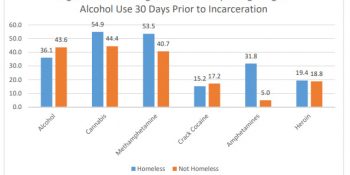Colorado Division of Criminal Justice Publishes Study of Homeless in Jails
The Colorado Division of Criminal Justice published a study exploring the demographics, characteristics, crimes and needs of a specific subset of Colorado’s current jail population: the homeless.
“A Study of Homelessness in Seven Colorado Jails” surveyed 507 inmates in jails in Arapahoe County, the City and County of Denver, El Paso County, Larimer County, Mesa County, and Pueblo County. The sites were chosen because they represent a good cross-section of jurisdictions in Colorado that experience the impacts of homeless populations.
The Division of Criminal Justice commissioned Eris Enterprises to conduct the study to provide data that may help answer questions being raised by law enforcement, legislators and community members in relation to a reported increase in the homeless population in major Colorado jails and in Colorado in general. The study examined the prevalence of risk factors associated with homelessness, the types and number of crimes committed, home state origin, why non-native inmates moved to Colorado, and what services inmates need to transition out of jail. In particular, the study sought to provide insight on one frequently posed question: is Colorado seeing an increase in homeless people moving to Colorado for legal marijuana and then committing crimes?
 SUMMARY OF RESULTS
SUMMARY OF RESULTS
The study found that the majority of homeless who ended up in Colorado jails moved here prior to legalization of marijuana, and most moved here to escape a problem or be with family. However, more than one third of the homeless who moved to Colorado after legalization in 2012 reported legal marijuana as a reason that drew them to Colorado.
The study also found that homeless inmates reported higher rates of mental illness and were charged with significantly fewer violent crimes but significantly more drug and trespassing crimes than non-homeless inmates.
“This study helps us better understand what is happening with homeless in Colorado’s jails. What we’ve learned is that homeless individuals have been coming to Colorado since before legalization of marijuana, driven by a combination of push and pull factors. They are fleeing problems and coming here for family, jobs, friends, and, in some cases, for legal marijuana,” said Stan Hilkey, Executive Director of the Department of Public Safety.
He added: “The findings also underscore we already know: that Colorado’s jails already have far too many people in them with mental health and substance abuse issues. That’s why efforts to address mental health and substance abuse issues remain a top focus in our state and nationwide.”
HOW THE STUDY WAS CONDUCTED
Researchers administered questionnaires to 507 inmates at the seven jails between June and October of 2017. The study was designed to over-sample the homeless population in jails in order to have a large enough group of homeless subjects to make estimates about current trends in Colorado. It does not necessarily represent the overall population of the seven jails, but it does represent a random sample of both homeless and non-homeless inmates in those jails.
Of the sample, 60.8% reported experiencing homelessness in the 30 days prior to entering the jail. This indicates that the over-sampling technique worked and the homeless sample is large enough to produce estimates of different indicators.
DATA HIGHLIGHTS
-
62% of the sample moved to Colorado from other states; of those who came from other states, 59% moved to Colorado before legalization in 2012.
-
The most common states of origin for homeless inmates were California, Texas, Arizona, Louisiana, and New Mexico.
-
Among the 77 homeless inmates who moved to Colorado after marijuana was legalized in 2012, top reasons cited for moving to Colorado were:
- Getting away from a problem (44.2%)
- Family (38.9%)
- Marijuana (legal and medical) (35.1%)
- Employment (24.1%)
-
The most common reasons non-native homeless inmates said they stay in Colorado were:
- Family (31.1%)
- Outdoor activities (28.3%)
- Friends (26.6%)
- Employment (24.1%)
- Marijuana is the sixth most common reason, with 18.5% reporting that as a reason they stay in Colorado.
-
Homeless inmates had significantly fewer violent crime charges than non-homeless inmates.
-
Homeless inmates had significantly more drug crime and trespassing charges than non-homeless inmates.
-
There was no difference in the total number of charges, number of charges for property crimes, or number of charges for other types of crime.
-
Homeless inmates were more likely to report having been diagnosed with a substance abuse disorder (55.9%) and having a mental illness (64.2%) than non-homeless inmates (35.3% and 46.4%, respectively).
The complete study, with additional findings and graphs can be found here.
SPREAD THE NEWS
COMMENT, Like, Follow & SHARE @I70Scout
CURRENT EDITION
WEATHER & TRAFFIC PUZZLES RECENT NEWS ADVERTISE WITH US

Leave a Reply